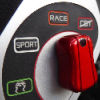20k miles hard tracking...
1k Road miles

To be honest, I'd guess the opposite of that would be true, with fair reasons:
If you think about it, most tracks have pretty smooth tarmac, so the only bumps/shock loading the car takes is when (and if) you go over rumble strips on the side of the track (which might be 5% of the length of the track).
However, on the sorts of B-roads some of us drive on, every single metre can be on poor tarmac (ie as high as 50%), loads of pot holes and sometimes broken tarmac on the side of the road, man holes, poor tarmac seam joins on the centre line etc etc. Seeing as this bad surface is constantly causing the suspension to bounce around, I'd say it hammers the bushes and joints a lot more than smooth track tarmac.
Garaging a car is obviously well known to help reduce the ageing process on a car and I think would have a positive effect on the rubber's life. Mainly because it stops the extreme hot & cold getting to the car and perishing the rubbers. Also, not having direct sunlight on paintwork and tyre sidewalls helps a lot. Finally of course it isn't subject to rain water and/or frost.
In my case, my car has been garaged for the last 10 years. Yesterday (by chance) I did a test on a 3.5 year old wishbone with around 25,000 miles on it, that I had taken off the car a couple of weeks ago. I put the wishbone into a big vice and inserted a bar into the 2 bushes and twisted it to see how much movement there was. Both bushes were rock hard, even more so than I expected with absolutely no sign of play.
However, whist inspecting all my 13 year old ball joints over the last few months, I would say all of these have suffered badly and replacing each one has made a noticeable improvement of "tightness".
Hence, my advice on rates of wear and order of replacement is (approximately):
1. Inspect/replace hub carrier bolts (every year or two, or after any kerbing incident or very severe pot hole).
2. Inspect/replace (and check torque) rear tie rod joints (every year or two).
3. Replace upright ball joints, track rod ends (maybe (and very roughly) every 50,000 miles).
4. Refurb coilovers, perhaps every 50,000 miles if you drive on smooth roads, perhaps every 25,000 miles if you drive on bumpy stuff.
5. Replace bushes (rarely needed and only after inspection and testing in a vice).
Of course, the more often you do these inspections and refurbs, the better your car will drive. I recently had my Nitrons refurbed again after only 3.5 years and was shocked how much of an improvement it made. Next time I will be sending them back after maybe only 2 years as the performance improvement was that great.
This is just based on my own inspections and replacements on my garaged car however and no doubt will conflict with others experience, hence I'd only suggest the above list as a very rough guide. Ultimately, you will have you use your own judgement based on the roughness of surfaces you normally drive on, how much you value a sharp/accurate response from your car, your time + money budget, your desire to stay alive (in the case of tie bar joints, HCBs and track rod end joints).
HTH.
Edited by Nev, 13 June 2016 - 06:06 AM.





















